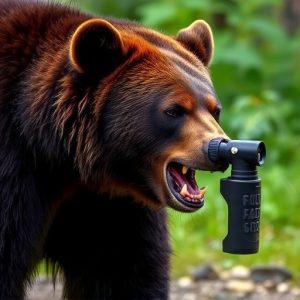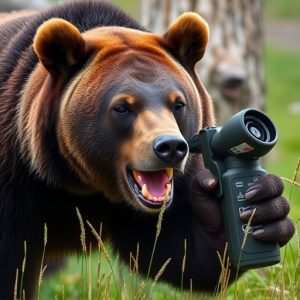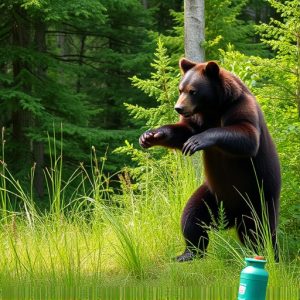Wilderness Safety: Bear Spray vs. Regular Pepper Spray for Grizzly Defense
Understanding grizzly bear behavior is crucial for wilderness survival. Bear spray, with higher caps…….
Understanding grizzly bear behavior is crucial for wilderness survival. Bear spray, with higher capsaicin concentrations than regular pepper spray, deters charges up to 92% due to its effect on bears' eyes and respiratory systems. When facing a charging bear, bear spray's intense sting and rapid disability allow for safer interactions at greater distances. Choosing the right bear spray involves size, range, concentration, and agency approval. Staying calm, maintaining distance, appearing larger, and speaking firmly during encounters enhances safety. Pointing the spray at the bear's face from 20-30 feet away is effective if necessary.
In the vast wilderness, encountering a charging grizzly bear can be a terrifying reality. Understanding their behavior and having the right tools are key to survival. This article explores the unique challenges of dealing with these powerful creatures, focusing on the role of bear spray. We delve into the science behind its effectiveness compared to regular pepper spray, offering insights on choosing the best defense for your adventures. Learn essential safety tips to navigate these encounters and gain knowledge that could save lives in the wild.
- Understanding Grizzly Bear Behavior and Their Charging Patterns
- The Science Behind Bear Spray: How It Works and Its Effectiveness
- Regular Pepper Spray vs Bear Spray: Key Differences and Comparisons
- Choosing the Right Bear Spray for Your Wilderness Adventures
- Safety Tips and Best Practices When Confronting a Charging Grizzly Bear
Understanding Grizzly Bear Behavior and Their Charging Patterns
Understanding Grizzly Bear Behavior is Key to Survival in the Wilderness. These powerful animals are typically wary of humans, preferring to avoid conflict. However, when they do charge—often a response to feeling threatened or surprised—it’s crucial to know how to react. Research shows that grizzlies often make charging movements as a form of communication rather than an aggressive attack. They may be trying to assert space or warn you away from their territory.
When considering defense options, many turn to bear spray as a primary deterrent. Unlike regular pepper spray designed for human confrontations, bear spray is specifically formulated to create a barrier between the bear and the user. It’s effective in reducing bear aggression over a wide area, providing a crucial few seconds for escape or retreat. Bear spray is a vital tool when navigating grizzly country, but understanding the animal’s behavior can enhance its effectiveness and reduce the risk of an encounter altogether.
The Science Behind Bear Spray: How It Works and Its Effectiveness
Bear spray, specifically designed for use against bears, has become a standard tool for outdoor enthusiasts navigating wilderness areas known for bear populations. Unlike regular pepper spray, which irritates the eyes and respiratory system, bear spray is formulated to create a significant barrier between the user and the bear. It contains capsaicin, the active ingredient in chili peppers, at much higher concentrations than regular pepper spray. This potent irritant not only stings the bear’s eyes but also triggers a natural instinct to avoid and retreat.
The effectiveness of bear spray lies in its ability to provide a non-lethal deterrent. When sprayed directly into an approaching bear’s face, it temporarily blinds and disorients the animal, allowing the human to create distance and escape. Studies have shown that when used correctly, bear spray can reduce attack risk by up to 92%. However, it’s crucial to understand its limitations; wind direction and proximity play significant roles in its success. Bear spray Vs regular pepper spray, the former is specialized for larger, more aggressive animals like grizzly bears, ensuring a better chance of deterring an attack.
Regular Pepper Spray vs Bear Spray: Key Differences and Comparisons
When it comes to facing off against a charging grizzly bear, choosing the right self-defense tool is paramount. Herein lies the debate between regular pepper spray and specialized bear spray. While both aim to incapacitate through irritation, they differ significantly in effectiveness and application against larger, more powerful predators like bears.
Regular pepper spray, designed for human confrontations, typically contains capsaicin in concentrations that can cause temporary blindness, coughing, and respiratory distress in humans. However, tests have shown that it may not be potent enough to deter a bear. In contrast, bear spray is formulated specifically for wildlife encounters. It usually has higher concentrations of capsaicin and other irritants, making it more effective at stopping bears due to its intense sting and rapid onset of disability. Additionally, bear spray can reach further distances, allowing for a safer level of interaction before retreating.
Choosing the Right Bear Spray for Your Wilderness Adventures
When venturing into bear country, selecting the appropriate bear spray is a critical component of your safety strategy. It’s essential to understand that bear spray is distinct from regular pepper spray, designed specifically to deter aggressive bears. Bear sprays typically contain higher concentrations of capsaicin, the active ingredient that irritates a bear’s eyes and respiratory system, encouraging it to retreat.
Choosing the right bear spray involves considering factors like canister size, spray range, and concentration. Look for products approved by respected testing agencies for guaranteed effectiveness. Water-based sprays might be lighter but less potent, while oil-based options offer longer-lasting protection against bears’ thick fur. Ensure you’re familiar with the instructions and practice using it before your trip to ensure its proper deployment when facing an encounter.
Safety Tips and Best Practices When Confronting a Charging Grizzly Bear
When faced with an approaching grizzly bear, staying calm and knowing how to react is crucial for your safety. One of the most important tools in your arsenal is bear spray—but not just any bear spray. Bear spray is specifically designed to deter bears, using capsaicin to irritate their eyes, nose, and throat, causing them to retreat. It’s more potent than regular pepper spray, making it more effective against large predators like grizzlies.
Best practices include ensuring you have bear spray readily accessible and know how to use it correctly. Keep a safe distance from the bear—at least 100 yards—and never run. Running may trigger the bear’s chase instinct. Instead, make yourself appear larger by raising your arms or opening your jacket. Speak firmly but calmly to let the bear know you’re human and not prey. If using bear spray, point it towards the bear’s face from a distance of 20-30 feet, creating a barrier between you and the bear.
When venturing into grizzly bear country, understanding their behavior and equipping yourself with the right defense are key. Bear spray has proven its worth as an effective deterrent against charging bears, offering a significant advantage over regular pepper spray in terms of range and power. By choosing the appropriate bear spray and adhering to safety practices, you can enhance your chances of staying safe during outdoor adventures. Remember, knowledge and preparation are essential tools in navigating potential bear encounters.


